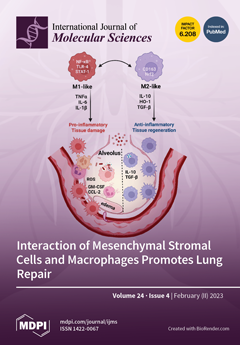17α-Methyltestosterone (17MT), a synthetic organic compound commonly found in sewage waters, can affect reproduction in aquatic animals, such as tilapia and yellow catfish. In the present study, male
Gobiocypris rarus were exposed to 25, 50, and 100 ng/L of 17α-methyltestosterone (17MT) for 7
[...] Read more.
17α-Methyltestosterone (17MT), a synthetic organic compound commonly found in sewage waters, can affect reproduction in aquatic animals, such as tilapia and yellow catfish. In the present study, male
Gobiocypris rarus were exposed to 25, 50, and 100 ng/L of 17α-methyltestosterone (17MT) for 7 days. We first analyzed miRNA- and RNA-seq results to determine miRNA-target gene pairs and then developed miRNA-mRNA interactive networks after 17MT administration. Total weights, total lengths, and body lengths were not significantly different between the test groups and control groups. The paraffin slice method was applied to testes of
G. rarus in the MT exposure and control groups. We found that there were more mature sperm (S) and fewer secondary spermatocytes (SSs) and spermatogonia (SGs) in the testes of control groups. As 17MT concentration increased, fewer and fewer mature sperm (S) were observed in the testes of male
G. rarus. The results showed that FSH, 11-KT, and E2 were significantly higher in individuals exposed to 25 ng/L 17MT compared with the control groups. VTG, FSH, LH, 11-KT, and E2 were significantly lower in the 50 ng/L 17MT exposure groups compared to the control groups. VTG, FSH, LH, 11-KT, E2, and T were significantly lower in the groups exposed to 100 ng/L 17MT. High-throughput sequencing revealed 73,449 unigenes, 1205 known mature miRNAs, and 939 novel miRNAs in the gonads of
G. rarus. With miRNA-seq, 49 (MT25-M vs. Con-M), 66 (MT50-M vs. Con-M), and 49 (MT100-M vs. Con-M) DEMs were identified in the treatment groups. Five mature miRNAs (miR-122-x, miR-574-x, miR-430-y, lin-4-x, and miR-7-y), as well as seven differentially expressed genes (
soat2,
inhbb,
ihhb,
gatm,
faxdc2,
ebp, and
cyp1a1), which may be associated with testicular development, metabolism, apoptosis, and disease response, were assayed using qRT-PCR. Furthermore, miR-122-x (related to lipid metabolism), miR-430-y (embryonic development), lin-4-x (apoptosis), and miR-7-y (disease) were differentially expressed in the testes of 17MT-exposed
G. rarus. This study highlights the role of miRNA-mRNA pairs in the regulation of testicular development and immune response to disease and will facilitate future studies on the miRNA-RNA-associated regulation of teleost reproduction.
Full article






